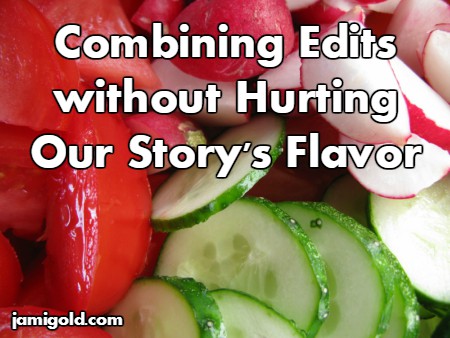Once we’ve been writing for a while, we’ve heard enough about the process that we know our draft will be imperfect. (We still might not like that fact—or panic when our rough draft is less than awesome—but we “know” it on an intellectual level at least. *smile*) So it stands to reason that our draft needs editing to fix, strengthen, tighten, and improve our writing and our story.
Given that truth, and given that many authors choose to self-publish or that some publishers have cut back on the editing stage of the process, we might need to pay freelance editors for some (or all) of the editing our story requires. Of course that costs money.
I’ve written before about some of our options for saving money on editors:
- Beta readers
- Manuscript analysis/critique
- Partial edit
- Alpha readers
- Self-editing
However, another option we might think to try is combining some of the steps of editing.
A full editing process involves 3 or 4 steps (development, line, copy edits (and proofing)). That’s a lot of different editors to pay. But if we could combine some of those steps, we’d save money. Right?
Luckily we have Lisa Poisso filling in for me during NaNoWriMo here today to walk us through the various combinations we might consider. She’s sharing the pros and cons of various editing combinations—as well as the issues that make certain combinations ones to avoid.
Please welcome Lisa Poisso! *smile*
*****
How Can We Successfully Combine Editing Services?
by Lisa Poisso
Editing budgets are shoestring affairs for most emerging authors. You know your novel may not earn back the money that goes into producing it, so you learn to DIY and trade critiques with other authors.
But then you hear about an editor offering combo edits that cover story editing and proofreading for a single price. What’s that all about? Would that work for your book?
Ahh, if only it were practical to ask an editor to “whisk through and clean up my copy—oh, and let me know if you spot any story issues along the way.”
Different levels of editing focus on entirely different goals and approaches, and forcing a fit could be asking for trouble. Here’s how to play it smart.
The 3 Types of Editing
You’ll immediately catch on to which editing services fit together well and which don’t once you grasp the goals of each type of editing.
Editing comes in three basic flavors: feedback on the story, editing for the writing itself, and a final cleanup of the edited manuscript.
1. Story-Level Editing
This level includes manuscript critiques (also called evaluations or assessments) and developmental editing (aka content editing, story editing, structural editing, or substantive editing).
Your editor will analyze the foundations of your story (plot structure, characterization, conflict, and so on) to make sure everything works together to create a page-turning read. This type of editing also looks at your narrative technique—things like point of view, pacing, transitions, hooks, and dialogue tags and beats.
Story-level editing is one of the most expensive and time-consuming editing services. It’s designed to be followed by revision or rewriting.
2. Writing-Level Editing
This is the kind of editing most people think of when they think about book editing: fixing typos and correcting spelling errors and sorting out grammatical messes.
This category includes line editing (or stylistic editing), which is designed to polish and raise the quality of your writing, and copyediting, which ensures your writing is clean and correct.
Line editing costs more than copyediting. Line editing is designed to be followed by revisions at the paragraph and sentence levels, while copyediting is designed to be the last time anyone edits your manuscript.
3. Final-Level Review
By the final review, you’ll no longer be tweaking the story or improving the writing. This step is designed to catch any last errors—think typos and bloopers.
This is the quickest and least expensive type of editing. It’s designed to make only the changes that are absolutely necessary.
So how do you know which editing services you need, how to prioritize them, and whether you can combine any of them to ease your budget?
Seek Your Editor’s Recommendations
What editing help does your story need? Ask editors for recommendations. Click To TweetIf you’re working with a finite editing budget (and who isn’t?), it only makes sense to aim for the quickest and least expensive type of editing. That would be a final cleanup—but if your manuscript hasn’t already had a line edit or copyedit, your editor will by definition have to work at a deeper level.
Don’t guess at what your book needs. There’s no one-size-fits-all editing plan that fits every manuscript.
On top of that, every editor defines their services a little differently. Find out what’s included in your editor’s services, and then ask for their recommendations for your manuscript.
Use Sample Edits for Assessment if Applicable
A sample edit helps editors estimate what kind of attention your manuscript needs and lets you see what their work will look like on your manuscript.
It’s not possible to perform a sample edit at the developmental level, because grasping story-wide problems requires reading the entire manuscript—something that’s outside the scope of a brief initial assessment. (Note from Jami: I’ve recommended asking to submit a sample for a no-feedback evaluation, just so a developmental editor could analyze whether they think they’d be a good match for your story’s needs.)
Not every editor offers sample edits; some charge for them, with the fee applied to your edit.
Share Your Goals and Budget with Your Editor
But your editor can do more than simply suggest editing services that might fit your manuscript. A savvy editor will ask you about your editing budget and publishing goals and then help you develop an editing plan that moves you toward your goals without busting your budget.
Are You on the Same Page?
Your editor’s philosophical approach is another part of finding the right fit. Are you looking for a long-term creative partner to coach you to the next level? Or do you simply want someone to get this thing cleaned up and prepped for publication? The wrong fit here could create more problems than it solves.
Develop Priorities That Fit Your Publishing Goals
A heart-pumping plot sells more books than correct commas every single time, but developmental editing is expensive. Should you bite the bullet and put your story first?
How can we balance our story's editing needs with our budget? Click To TweetBut you can’t neglect writing-level errors. Readers will give up on a hot, unedited mess long before they’ve discovered your gem of a story inside.
Let’s face it: until you’re cranking out bestsellers or unless you’re supporting your writing with another career, you’re probably not going to be able to swing a developmental edit plus a line edit plus a copyedit plus proofreading (as well as cover design, interior design, and marketing support).
Before you try to DIY the whole load by yourself, talk with your editor. Many editors offer outline or synopsis reviews, story critiques, paid beta reading services, hourly coaching, and other services that’ll get you across the finish line with as polished a manuscript as your budget permits.
How and When to Combine Editing Services
When your budget won’t budge, it’s usually smarter to seek more affordable editing alternatives than it is to combine services.
- Instead of a developmental edit, explore peer critique, workshopping, and beta reading.
- Instead of proofreading, a carefully curated team of friends, family, and beta readers might cover the bases.
Don’t get slammed trying to cram incompatible processes into the same box. Some editors will offer to do combo edits; I’ve made a few rare exceptions myself.
The thing is, story edits, writing edits, and final reviews are different on an intrinsic level. You can’t simply lay one over the top of another. Each process has a different goal.
Let’s look at the possibilities for combining the three levels of editing: the story-level edit, the writing-level edit, and the final-level review.
Story-Level Edit + Writing-Level Edit:
This is the infamous combo every author secretly dreams of, the “quick breeze through the manuscript for errors plus notes on any weak spots in the story.”
Here’s the problem:
The goal of a story-level edit is to identify weaknesses in the story in preparation for revision or rewriting, but the point of a writing-level edit is to polish the writing that’s already on the page.
Why pay an editor to crawl over the spiderweb of sentence structure if you’re also asking for recommendations that might involve revising or deleting entire sections?
Cramming story-level editing together with writing-level editing inevitably degrades the quality of the final results. Asking an editor to identify story issues involving plot, characterization, and pacing at the same time as they’re sifting through your writing at the paragraph, sentence, and word levels makes for mighty multitasking—and editing is not a multitasking process.
Editing requires focus. It demands precision, the kind of precision that comes from immersion and flow.
Your editor won’t be thinking about the pacing of your story if they’re rooting around in your grammar and spelling. Sure, you’ll be getting a little story feedback on top of some decent writing-level editing—but you won’t be getting the full treatment on either.
Substantive Editing—a Compromise?
Substantive editing is one approach to combining writing-level editing with a look at some larger issues.
Many editors use the term substantive editing to refer to developmental editing; in this case, I’m referring to something in between developmental editing and line editing.
Experienced authors who write tight can combine edits more easily. Click To TweetIn my own practice, substantive editing is like a line edit that dips into the elements of narrative technique I typically include in a developmental edit, such as point of view and narrative distance, dialogue tags and beats, the balance of showing vs. telling, and filtering. I look for minor story issues during a substantive edit, too, as long as they don’t require major revision or rewriting.
Substantive editing is a slow, expensive service because it typically means multiple editing passes. Even so, it’s less costly than a developmental edit plus a line edit or copyedit, so it could be a good fit for a seasoned author with a tight manuscript and a tight production schedule. Still, it’s not ideal if you’re looking for a comprehensive edit.
Story-Level Edit + Final-Level Review
This combo is even less likely than a story-level edit plus a writing-level edit. Surely you can grasp the futility of attempting to dot all the i’s and cross all the t’s while simultaneously implementing sweeping revisions. As they say where I live, this dog won’t hunt.
Writing-Level Edit + Final-Level Review
There’s a name for editing previously unedited copy: copyediting, a writing-level service. You could get a line edit (tuning and polishing) on top of a copyedit (mechanics and style), but you can’t get a final review at the same time as an actual round of editing. This combination of services is physically impossible within a single editing round.
The Right Editorial Fit
If none of these editing descriptions are ringing your bells, maybe you need another kind of service altogether:
- Maybe you need a little help moving forward—a writing coach to help you master new techniques or a book coach to help keep your creative process on track.
- Maybe you’d like someone to scoop up your incomplete manuscript and carry it across the finish line for you—that’s ghostwriting.
- Maybe you’d prefer to turn the whole thing over to a creative services pro who can handle it all: editing, design, and production.
Beware of editors who claim they can edit any type of writing or give you a package including any type of editorial service you need. Ask how they will accomplish that. What’s included?
A smart editing plan involves more than hiring a qualified editor to provide the expected services. Your plan should balance the needs of your book against the demands of your publishing goals.
The best way to get a handle on the available options is to seek out like-minded authors. Find others on social media who are doing what you want to be doing, and soak up their experiences, good and bad.
If you want to write bestselling commercial fiction, look for groups filled with experienced authors who publish like clockwork. If you aspire to be traditionally published, meet and learn from others who have. Find your tribe, and you’ll absorb a broader sense of the path to publication that makes sense for you.
*****
 Lisa Poisso works with traditionally publishing and self-published authors to show them how to lift their stories to their full potential. She specializes in editing and coaching for commercial fiction, particularly upmarket and women’s fiction, action-adventure, and thrillers. She’s also a seasoned editor of fantasy, science fiction, and all flavors of speculative fiction.
Lisa Poisso works with traditionally publishing and self-published authors to show them how to lift their stories to their full potential. She specializes in editing and coaching for commercial fiction, particularly upmarket and women’s fiction, action-adventure, and thrillers. She’s also a seasoned editor of fantasy, science fiction, and all flavors of speculative fiction.
Lisa has been a publication editor, journalist, managing editor, content writer, and communications consultant for more than 25 years. She holds degrees in journalism and fine arts and remains a working writer. She’s a member of the Editorial Freelancers Association and a charter member of the Association of Independent Publishing Professionals. Her studio staff includes her industrious editorial assistants—two greyhounds and a staghound. #45mphcouchpotatoes #adoptdontshop
LisaPoisso.com | Twitter: @LisaPoisso | Facebook | Pinterest
*****
The Plot Accelerator
Don’t drain your editing budget on a story that’s not ready for prime time. The Plot Accelerator is an affordable way to make sure your novel has all the story power it needs to succeed as commercial fiction—before you commit your editing budget, or even before you begin writing.
The Plot Accelerator is a virtual consultation that helps you build your story using proven storytelling techniques. It’s like a developmental X-ray of the bones of your story. You get tutorials, analysis, and one-on-one feedback on your story’s foundations.
The Plot Accelerator is designed for authors who want the faster writing times that come from well-developed story foundations and outlining; authors seeking an affordable story-level diagnostic tool for their final drafts; and authors who want story editing but don’t have the budget or time for an evaluation or developmental edit.
Book It: The Plot Accelerator
*****
Thank you, Lisa! You touch on so many wonderful points that I hardly know where to start. *grin*
Like I mentioned to Lisa when she first proposed this post topic, as an occasional freelance developmental editor, I often hear from potential clients who think my story-level edit is all they’ll need, or they try to schedule a story edit with me after line or copy edits—and that’s just not how the editing process works.
That said, as Lisa alluded to, some editors can cross the lines between types of edits. My line editor will occasionally give story-level feedback and copyedit changes. But I wouldn’t expect her to do a full job on either, so it’s all about matching our priorities to our story’s needs and our goals and budget.
Also, as a side note, I’ve seen some editors offer combo packages, where they’ll do multiple passes on our work to cover the different levels of editing:
- Some will do multiple passes on a single draft—which runs into the same problems Lisa mentions above about trying to polish a scene that might need to be completely rewritten.
- Others will do additional passes on separate drafts after the author makes their initial changes—which would seem to overcome some of the issues pointed out in the post.
My concerns with the second style are two-fold. First, just as we can suffer from not having “fresh eyes” to self-edit our work, editors can run into the same problem. Also, the different editing styles require different strengths. They might not be as good about finding issues on a follow-up pass, or they might not be good with every style of editing, so ask questions to determine their experience and strengths.
As Lisa mentioned, the easiest styles to combine are the two writing level edits: line and copy edits. Like her suggestions, if someone could afford only one editor, I’d also recommend focusing on the writing level because finding a good match for our voice is essential for line editing. Then I’d use strong beta readers for the developmental editing story-level and eagle-eyed friends for the final proofread review.
We all understand the desire to save money, so hopefully this post gives us ideas for how to make the most of our editing budget. As we all know, a talented edit can take our story from good to great. *smile*
Have you struggled to know what editing types to prioritize or if they could be combined? Does this post help explain the pros and cons? Have you ever had a combined edit, and if so, how did it work for you? Do you have any other suggestions or warnings to share on this subject? Do you have any questions for Lisa?


